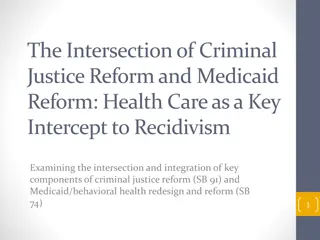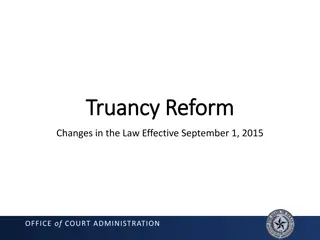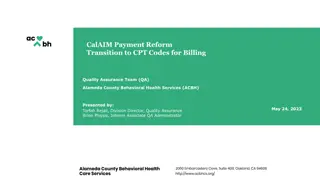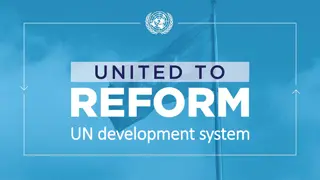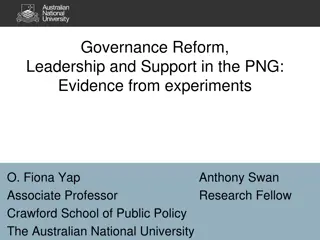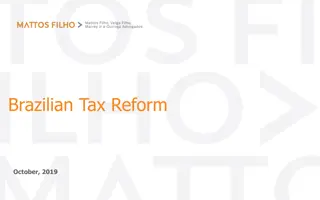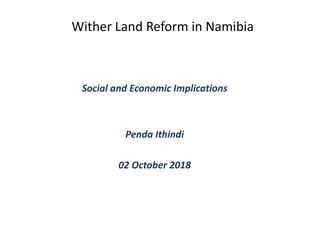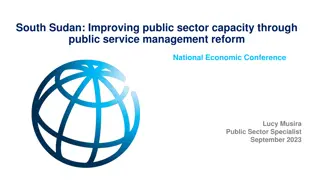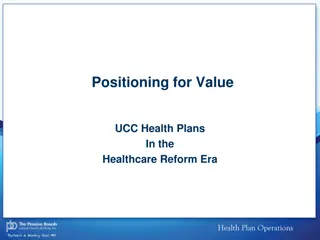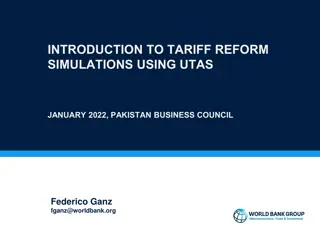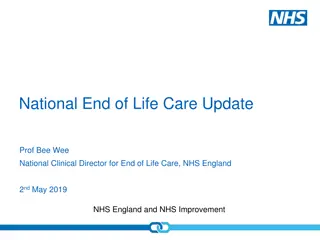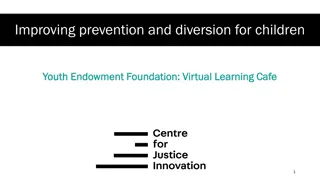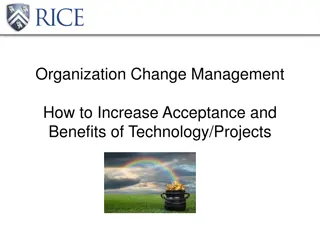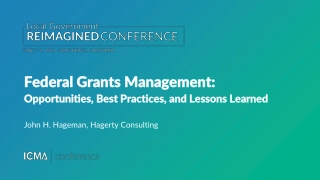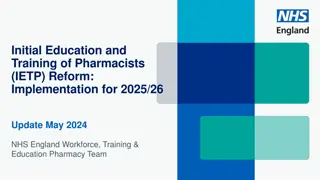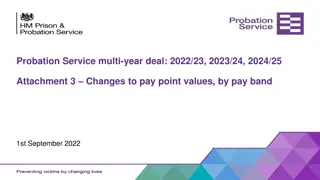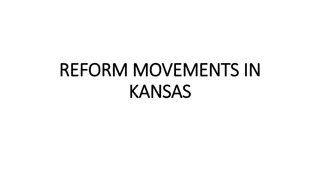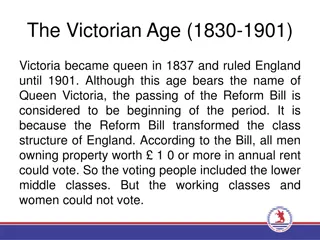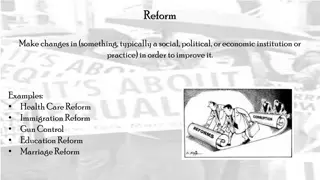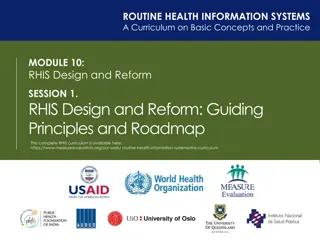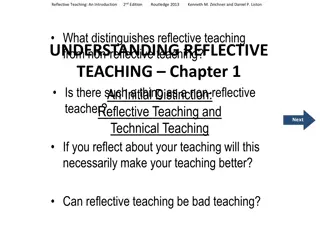Effective Benefits Management in Reform Initiatives
Learn about the importance of benefits management in UN reform projects, including defining benefits, strategic vision alignment, benefit categories, and the project level benefits management cycle. Discover how benefits management contributes to accountability, transparency, and continuous improvement in achieving organizational objectives.
Download Presentation

Please find below an Image/Link to download the presentation.
The content on the website is provided AS IS for your information and personal use only. It may not be sold, licensed, or shared on other websites without obtaining consent from the author. Download presentation by click this link. If you encounter any issues during the download, it is possible that the publisher has removed the file from their server.
E N D
Presentation Transcript
Benefits Management Benefits Management Project Level Benefits Statement Planning Guidance March 2019 1
Definition Definition A benefit is defined as a measurable improvement resulting from an outcome perceived as an advantage by one or more stakeholders, which contributes towards one or more organizational objectives.* This means we require: measurable improvement requires a clear understanding of business performance before and after a change has been introduced. Performance can be judged using a balanced set of metrics which track, for example, quality, delivery, cost, people, safety and environmental performance. an outcome a targeted intervention / project to improve how or what is delivered. perceived as an advantage by stakeholders a clear understanding of who stakeholders are, what they value, and if they are satisfied. contributes to organisational objectives a golden thread between reform objectives and the benefits targeted by a reform initiative. * UK Infrastructure Projects Authority Project Level Benefits Statement Planning Guidance 2
Overview of benefits management Overview of benefits management The Secretary-General has committed to embed benefits management in the UN reforms process. The benefits management is important for the reforms: Accountability. A systematic approach to proving the results of UN reforms throughout the implementation process. Transparency. A mechanism to track that commitments are being carried out and improvement are being made. Continuous Improvement. A tool to enable the UN to identify areas where benefits can be replicated elsewhere, and course corrections when they are not being realised. Project Level Benefits Statement Planning Guidance 3
Benefit Categories Benefit Categories Guidance: Reform initiatives, and the benefits they deliver, derive their legitimacy from three interlinked sources: (a) the overall strategic vision for UN reform (b) the individual objectives of the reform pillars and (c) the organizational objectives of each organization. Consider the information below to explain how the reform project you are exploring will contribute to the overall objectives STRATEGIC VISION FOR UN REFORM Improving the UN s ability to deliver on its mandates, and increasing the confidence of Member States Increased transparency Simplification Empower managers Cross-pillar cooperation Capability Delegation BENEFITS CATEGORIES* Whole of pillar approach Coherence / coordination Accountability Organizational Functions Effectiveness Alignment Efficiency Gender Parity Project Level Benefits Statement Planning Guidance 4
Project level benefits management cycle Project level benefits management cycle A Benefits Management System works at both project and portfolio level. The focus of these slides is the project level. The benefits management cycle: 1. 2. Identify potential benefits Plan and baseline benefits, capturing in benefits statements Track performance against baseline 3. 4. 5. Realise benefits Confirm benefits Project Level Benefits Statement Planning Guidance 5
Purpose of this guidance Purpose of this guidance This document has been developed to support teams integrate benefits management into the reform project management cycle. This guidance is focused on Step #2 of the project level benefits management cycle Plan, the objective is to produce a benefits statement. Table of Contents: Benefits management questionnaire Benefits statement guidance Benefits statement template Project Level Benefits Statement Planning Guidance 6
Benefits statement questionnaire Benefits statement questionnaire # Question Response 1 What is the name of this initiative/project? 2 What stage is the initiative/project at in the project management cycle? 3 What is the status of an implementation plan for the initiative/project? 4 What work has been done to establish a benefits realization/management plan? 5 Could performance be baselined using existing material/data? If so, what material/data would you use? 6 Is a separate exercise needed to capture baseline performance data? If so, what material/data might be helpful? 7 Based on the implementation plan, when do you expect to see improvements from this project? Please detail potential timeline of benefits. 8 Who will own the benefits (i.e., responsible for delivering them)? Who will realise the benefits (i.e., reap the rewards)? 9 Project Level Benefits Statement Planning Guidance 7
What is a benefit? What is a benefit? Every improvement is a change, but not every change is an improvement . Benefits are how we know there has been an improvement. Outcomes Outputs Benefits (against overall objectives) (or deliverables) (improved performance) Description: The final product, goods and services produced by the organisation or reform initiative. The impact or consequence for stakeholders. Outcomes are what an organisation, or reform initiative, is trying to achieve. How we know the outcomes have been achieved, and are an improvement for stakeholders Example: Business Management For example, a new corporate service department has been established to support operations The department is providing more responsive, better quality service to operations % reduction in waiting times % increase in requests satisfied per week % increase in customer satisfaction % reduction in cost per transaction Project Level Benefits Statement Planning Guidance 8
Measuring the intermediate benefits of reform Measuring the intermediate benefits of reform Ultimate benefits Intermediate benefits Indicators Intervention(s) United Nations Development system better supports countries in achieving development goals Agencies buy and sell offerings from one another, decreasing overall cost of operations End-users received higher quality services Launch back office reforms to consolidate services and decrease costs Catalog of consolidated services developed Agencies conducted analysis to understand their internal costs and compare with outside offerings Example Benefits % decrease of costs of business operations % decrease of business ops cost compared to total % decrease of FTEs on business ops % of end-users that strongly agree that back office services are high quality # of agencies submitting service offerings to catalog # of agencies conducted analysis $ funds committedto the reform efforts # of FTEs dedicatedto the reforms that have cost Example Measures internal Learning: We are trying to confirm that if reform initiatives are successfully executed, the intermediate benefits will be achieved The ultimate benefit is the initiatives North star'; all reforms should contribute to achieving the ultimate benefits However it can be difficult to prove causality of an intervention in a complex system, with lots of different actors. To measure the benefit of reform we are looking to establish the objectives of the reform have been achieved 9
Types of benefits Types of benefits Benefits can be both financial and non-financial. To clearly articulate benefit statements for the reform initiatives, first determine which type of benefits your project benefits fall into. Types of benefits Financial* Non-Financial Non-cashable Cashable Qualitative Quantitative Performance improves using the same resource, or by avoiding an increase in resources which might have been required. No financial resources can be deployed elsewhere. Subjective, for example stated benefits such as customer perspectives, user satisfaction. Objective, tangible indicator using numerical values of hard performance data. May be financial or non-financial Quantifiable resources that are available to be redeployed elsewhere while maintaining performance (e.g. outputs and quality) *Note: the Secretary-General has been clear that the reforms are cost-neutral. Project Level Benefits Statement Planning Guidance 10
Types of measures Types of measures Measures help to understand how to tell if benefits are being realized and improvements occurring. Types of measures* Quality Delivery Safety People Cost / Effort Environmental Accidents Mortalities Sickness absence % errors % failure demand # customer satisfaction / reduced complaints % process compliance Carbon emissions Paper / consumables Lead time vs target Work completed vs level of demand Reduction in backlogs / waiting time Hand-offs % Delivery vs overhead split Cost per output Budget vs outturn Fraud & error rate Unused assets Staff time (hours) Staff morale Gender Parity Turnover Sickness absence Personal development plans Disciplinary cases *non-exhaustive list of measures Project Level Benefits Statement Planning Guidance 11
1 Benefits statement template Benefits statement template The Thought Process The Thought Process [ [Insert Project name Insert Project name] ] Note: This template is designed to support project teams develop benefits statements. Text in red explains the type of information necessary. Benefits owner: Who is the senior manager responsible for the performance of this area / process Benefit Focal Point: Who will coordinate on behalf of the project owner 1. Objective 2. Background Describe current situation, including a description of the reforms and if any changes have already been made / implemented. Use metrics where possible. Describe the objective of the reform in terms of improved performance AND the benefits category it is intended to contribute to ; e.g. Objective: Save time, costs and workload through the elimination of process steps Decrease response time to stakeholders Category: simplification, efficiency [See slide 3 for benefits categories] 4. Baseline 3. Target Benefits and measures Set out benefits and measures (See slides 8 and 9 for types of benefits and measures) Tip use the thought process in Slide 7, but only record the Benefits column e.g. 20 % decrease cost per output 10 % decrease in error rates Customer satisfaction increased etc Describe baseline (including method used) to baseline current performance, usually a mix of; Existing performance measures: e.g. ERP, RBM frameworks, Audit / evalutions, customer feedback provides a readily available performance baseline to monitor progress against. Custom made performance measures; e.g. no existing performance measures to use hence developed a snapshot of performance using standard techniques. Tip Keep this simple. Bespoke baselining exercises take time is what you already know good enough? Tip Think about who benefits the beneficiary and complete box 3&5 together 7. Realisation plan 5. Main beneficiaries List who [types of staff, organisations, Member States, Host governments] will benefit if performance improves. The beneficiaries need to be involved later in confirming benefits have been realised. Set out known milestones (from project plan) including likely dates from which benefits may be realizable even a date range will be useful How will we confirm the benefits are real and accurate as reported? 6. Risks to benefits What will stop us achieving benefits or the limitations in proving the benefits? E.g. Can t measure improvement Risk can t scale up and roll out across other entities Might increase costs elsewhere No ownership etc 12 Project Level Benefits Statement Planning Guidance
2 Benefits statement template Benefits statement template The results The results Benefits owner: Benefit Focal Point : Benefit Description Benefits category Benefit Indicators Type of benefit Beneficiaries Baseline Baseline Year Realisation due? Benefits Statement Box 3. Benefits statement Box 1 Benefits Statement Box 3. NB This may require multiple indicators per benefit Measurable / stated / both Box 5 of the Benefits Statement. May be multiple beneficiaries Benefits Statement Box 4 NB state the current baseline Benefits Statement Box 4 From Box 4 - from which Quarter / Year benefits are expected to start accruing
1 Benefits statement template Benefits statement template The Thought Process The Thought Process Benefits owner: Benefits Focal Point: 1. Objective 2. Background 3. Potential Benefits and Measures 4. Baseline method 7. Realisation plan 5. Main beneficiaries 6. Risks to benefits 14
2 Benefits statement template Benefits statement template The results The results Benefits Owner: Benefit Focal Point : Benefit Description Benefits category Benefit Indicators Type of benefit Beneficiaries Baseline Baseline Year Realisation due?


